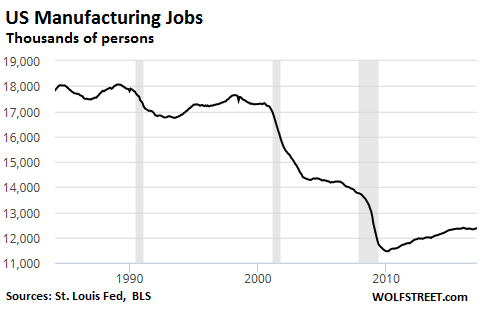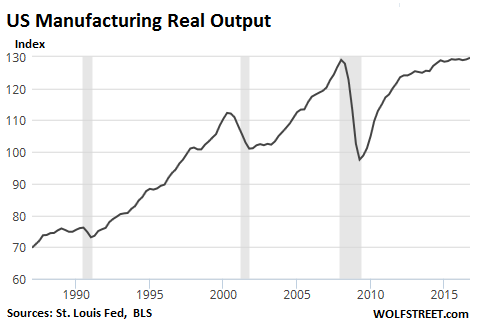

| Online: | |
| Visits: | |
| Stories: |
How Many Jobs Do Robots Destroy? Answers Emerge
by Wolf Richter, Wolf Street:
 But this isn’t the industrial revolution.
But this isn’t the industrial revolution.
How many jobs do robots – whether mechanical robots or software – destroy? Do these destroyed jobs get replaced by the Great American Economy with better jobs? That’s the big discussion these days.
The answers have been soothing. Economists cite the industrial revolution. At the time, most humans replaced by machines found better paid, more productive, less back-breaking jobs. Productivity soared, and society overall, after some big dislocations, came out ahead. The same principle applies today, the soothsayers coo.
But this isn’t the industrial revolution. These days, robots and algorithms are everywhere, replacing not just manufacturing jobs but all kinds jobs in air-conditioned offices that paid big salaries and fat bonuses.
Just today, BlackRock announced a plan to consolidate $30 billion of their actively managed mutual fund activities with funds that are managed by algorithms and quantitative models. As these software robots take over, “53 stock pickers are expected to step down from their funds. Dozens more are expected to leave the firm,” as the New York Times put it.
“We have to change the ecosystem – that means relying more on big data, artificial intelligence, factors and models within quant and traditional investment strategies,” BlackRock CEO Laurence Fink told The Times.
In a similar vein, “robo-advisors” are becoming a cheap and hot alternative for many customers at major brokerage houses, replacing human financial advisors. A lot of the grunt work that used to be done during all-nighters by highly paid law school grads in big law offices is now done by computers.
So job destruction due to automation is not a blue-collar thing anymore. It’s everywhere. But soothsayers have been steadfastly claiming that for each destroyed job, the Great American Economy will generate more and better jobs, because, well, that’s how it worked during, you guessed it, the Industrial Revolution.
But two economists have changed their mind (more on that in a moment) and published a gloomy working paper.
Daron Acemoglu and Pascual Restrepo studied how the increase of industrial robots between 1990 through 2007 has impacted US jobs and wages. They found “large and robust negative effects of robots on employment and wages across commuting zones.”
Their working paper is available at the National Bureau of Economic Research (NBER). This is the organization that is responsible for tracking US business cycles and calling “recessions.”
There are two effects of robots, the authors point out: The “displacement effect” when robots eliminate jobs; and the “productivity effect” as other industries or tasks require more labor and thus create jobs (for example, designing, making, and maintaining robots). But these productivity effects no longer suffice to compensate for jobs that industrial robots destroyed.
Specifically, they found that in a “commuting zone” with exposure to robots versus a “commuting zone” without exposure to robots:
Each additional robot reduces employment by a net of 6.2 workers.
Each additional robot per 1,000 workers reduces average wages by 0.73%.
Nationally – so beyond the commuting zone – effects were less massive as some jobs destroyed in Detroit might be replaced in other places:
One more robot per thousand workers reduces the US employment-to-population ratio by about 0.18-0.34 percentage points.
One more robot per thousand workers reduces US wages by 0.25% to 0.5%.
If the ratio of robots per 1,000 workers rises from 1 robot to 5 robots, wages would tumble by up to 2% nationally! In the same scenario within a “commuting zone,” wages would drop nearly 3%!
In 2014, there were 1.7 robots per 1,000 workers in the US, up from about 0.7 in 2000. Auto manufacturing is the leader in the use of industrial robots. Other sectors include electronics, metal products, plastics, and chemicals.
Between 1990 and 2007, industrial robots have eliminated a net of 670,000 jobs, according to the study. For perspective, this chart shows the total number of employees in manufacturing, which dropped by 36% from the peak of 19.5 million in 1979 to 12.4 million in February:

However, manufacturing output, adjusted for inflation, soared due to automation until 2007. During the Great Recession, output crashed. Now it has finally edged past its prior peak:

The number of industrial robots in the US is expected to quadruple. So job losses in manufacturing will continue, even if output rises.



